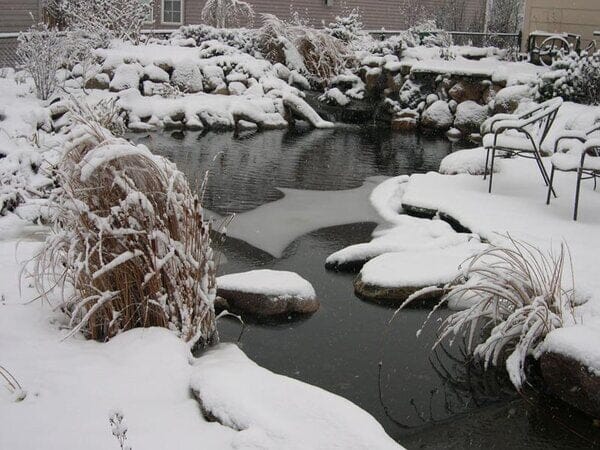Mon - Fri 9am-4pm
1(862)-362-1444
1(862)-362-1444
Mon-Fri 9am-5pm EST

Winter is coming—and your pond deserves some TLC to get through it! Knowing how to winterize your pond and prepare your fish for the cold months ahead is crucial for maintaining a healthy ecosystem. Over the year, ponds accumulate debris like leaves, twigs, grass clippings, and fish waste. If left unchecked, this can lead to toxic gas buildup and lower oxygen levels. But don’t worry—we’ve got you covered! Follow these steps to keep your pond in top shape all winter long.
Once the leaves have finished falling, it’s time to get started. Remove any pond netting and store it safely indoors to protect it from heavy snow and ice. Next, clean and store your pump and filter. If your pond has a waterfall or skimmer, disconnect the pump and check valve to let water drain out. For in-pond filtration systems, unplug, drain, and store them to avoid damage during freezing weather.
Use a submersible pump to lower the pond’s water level below the skimmer’s opening. Drain water from waterfalls and skimmers to prevent cracking from freezing and thawing cycles. If your pond doesn’t have a skimmer, you can skip this step.
Filter Media: Wash filter pads and bio balls from skimmers, waterfall boxes, or pressurized filters. Store them indoors or in the waterfall box for the winter. Replace any worn parts to save yourself trouble in the spring.
UV Clarifiers: Disassemble and clean the quartz sleeve with a soft cloth and white vinegar. Replace the UV bulb if needed, or add it to your spring checklist.
Pump: Remove debris, inspect for damage, and store the pump in a bucket of water to keep seals from drying out. Keep all components in a freeze-free location like a basement.
Plants go dormant in winter, so it’s time for a trim! Cut dead foliage just above the soil. If your plants are potted, move them to the bottom of the pond to protect the roots. Tropical varieties should be brought indoors or discarded.
Rotting leaves and twigs can stress your pond’s oxygen levels, putting your fish at risk. Use a hand net or pond vacuum like the ClearVac to clean out any remaining debris from ponds and streams.
Aeration kits and de-icers are your winter pond heroes. They keep a hole open in the ice, allowing harmful gases to escape and fresh oxygen to circulate. Place air stones in shallow areas to create a safe space for your fish. For extra peace of mind, add a pond heater to ensure ice stays open.
Switch your fish to a wheatgerm-based diet, It’s easier to digest in cooler temperatures. Feed your fish less as water temperatures drop below 50°F, and stop feeding entirely once temperatures hit 40°F.
Even after a thorough cleanup, some debris will remain. Use cold-weather bacteria like Seasonal Defense to break down any leftover muck. This will keep your pond clean through the winter and give you a head start in spring.
Here’s a quick list of all the gear you might need:
Pond netting
Hand net or vacuum
De-icer or pond heater
Pruning tools
Wheatgerm fish food
With these tips and tools, you’ll winterize your pond like a pro and keep it healthy and beautiful all season long. Happy pond prepping!